Abstract
Usually, when the computation of limiting distributions of (in)homogeneous (in)finite continuous-time Markov chains (CTMC) has to be performed numerically, the algorithm has to be told when to stop the computation. Such an instruction can be constructed based on available ergodicity bounds. One of the analytical methods to obtain ergodicity bounds for CTMCs is the logarithmic norm method. It can be applied to any CTMC; however, since the method requires a guessing step (search for proper Lyapunov functions), which may not be successful, the obtained bounds are not always meaningful. Moreover, the guessing step in the method cannot be eliminated or automated and has to be performed in each new use-case, i.e., for each new structure of the infinitesimal matrix. However, the simplicity of the method makes attempts to expand its scope tempting. In this paper, such an attempt is made. We present a new technique that allows one to apply, in one unified way, the logarithmic norm method to QBDs with countable state spaces. The technique involves the preprocessing of the infinitesimal matrix of the QBD, finding bounding for its blocks, and then merging them into the single explicit upper bound. The applicability of the technique is demonstrated through a series of examples.
Keywords:
inhomogeneous continuous-time Markov chains; weak ergodicity; logarithmic norm; QBD process MSC:
60J27; 60J28; 60K25
1. Introduction
When one thinks of analytical modeling tools in such areas as operations research [,], chemistry [], biology, and epidemiology [,], among the first that come to mind are the classic birth-and-death processes (BDP), or the more versatile quasi-birth-and-death processes (QBD) [,,]. A detailed bibliography (up to 1982) and a more recent one (up to 2004), which contain a large body of papers on particular applications of BDPs, can be found in [,]. Despite numerous available results for BDPs, they remain a topic of active research, with rich and practically useful results (see, for example, []).
Among all of the types of BDPs/QBDs, in this paper, attention is devoted only to two-dimensional (i.e., certain types of QBDs) possibly inhomogeneous continuous-time Markov chains (CTMC) with (countable) discrete state space. We recall that the inhomogeneity property implies that (some or all) transition intensities are non-random functions of time and (may or may not) depend on the state of the chain. These processes have been studied from various point of views: existence, numerical algorithms (see also the recent review in []), asymptotics, approximations, etc. One of the attempts to provide a systematic classification of the available approaches (up to 2016 within the framework of queueing theory) can be found in [].
In what follows, one specific question is addressed concerning the considered class of CTMCs, that is, the computation of the long-run, (limiting) time-dependent performance characteristics. This question can be considered from various point of views (computation time, accuracy, complexity, storage use, etc.). Therefore, various solution techniques are already available in the literature. One of the ways to improve the efficiency of a solution technique is to supply it with a method for the limiting regime detection or, in other words, a method providing ergodicity bounds. Indeed, once the limiting regime is reached, there is no need to continue the computation indefinitely. Therefore, the main contribution of this paper is finding new ergodicity bounds for certain well-known types of QBDs.
The results presented further continue the work whose first results were presented in [], which considered the well-known problem of finding upper bounds on the rate of convergence (in the norm) to the limiting regime of possibly inhomogeneous Markov chains with discrete state space and continuous time. One of the convenient methods for obtaining such bounds is the logarithmic norm method. However, when the logarithmic norm is positive (and for complicated models, this is often the case), the method yields meaningless bounds. One of the techniques that eliminates this critical drawback of the method, i.e., expands the scope of its application, is the use of weighted norms. However, by switching to the weighted norms, another problem comes to replace the original one: the problem of selecting the correct weights. Its solution in the general case is not known. Therefore, for each specific Markov chain, the proper weights have to be guessed, often by trial and error, and therefore this venture is not always successful. When one analyzes the available literature on this issue, it can be seen that for one type of infinitesimal matrices (generators), it is easier to guess the weights (if it is possible at all) than for others. Suggesting a classification is perhaps a matter for future research. However, as shown in [], the suggested observation is sufficient to develop a new technique that expands the scope of the logarithmic norm method. This is achieved by introducing the new step—preprocessing of the infinitesimal matrix. Later on, we will see that this expansion of the scope does not come for free: the resulting bounds may turn out to be very rough or (again) meaningless.
The preprocessing proposed in [] implied that, at first, one searches in the intensity matrix for blocks that are easier to analyze individually than the original matrix. Then, having obtained the bounds for the blocks, it remains to combine them into the single one estimate for the original Markov chain. In [], a corresponding method for combining estimates is proposed when the number of chain states is finite.In this paper, it will be shown that the idea of [] can be extended to countable Markov chains. Along the way, one has to overcome a number of analytical difficulties and introduce a number of conditions on the initial characteristics of the Markov chain. In this paper, we did not care about making these conditions as general and easy to check as possible. This is the subject of further research. Here, the emphasis is on demonstrating the efficiency of the method proposed in [] for countable Markov chains.
It is important to note that the results obtained in this article, together with the results of [], form one general approach for applying the simple logarithmic norm method to study the convergence of QBDs, which was previously possible to do only in very special cases.
2. Preliminaries
Let be a (possibly inhomogeneous) CTMC with the state space , which is allowed to be finite or countable. In the latter case, one assumes that either and or and . The transition probabilities will be denoted by , i.e., , . Let us also denote the state probability by , and the vector of state probabilities by . In what follows, it is assumed that
where all are uniformly in i, that is, . Moreover, if is inhomogeneous, then all its infinitesimal characteristics (intensity functions) are integrable in t on any interval , .
Denote for and . Further, in order to be able to obtain tighter estimates, it is assumed that
for almost all . The state probabilities then satisfy the forward Kolmogorov system
where the initial distribution is given, , and is the infinitesimal matrix of the CTMC.
Let be the usual -norm, i.e., for a vector and a matrix , it holds that and . Denote .
Therefore, for almost all , and we can apply the results of [] to Equation (2) in the space . Namely, in [], it was shown that the Cauchy problem for (2) has a unique solution for an arbitrary initial condition, i.e., if the initial condition is , then , , where is the Cauchy operator for (2). Moreover, if , then , for any and any initial condition .
In what follows, we will make use of the fact that subtraction of a given function from any row of the matrix does not change the CTMC’s convergence rate (see, for example, [,,]). Indeed, let denote the vector of ones, and ⊗ the Kronecker product. Then, for the vector of arbitrary functions , the system (2) can be rewritten in the form
Since for any , one has that . Therefore, for any two solutions and of the system (2), one has that
By subtracting, for example, the second equation from the first, for any constant diagonal matrix, say D, one obtains the new system of ODE
where ) and . In order for the Cauchy problem (3) with the initial condition to ensure a unique solution, one assumes that D is chosen such that is uniformly bounded in t, i.e., there exists such that for . Clearly, if D is the identity matrix, .
3. General Upper Bounds
Let us assume that one can represent the matrix in block three-diagonal form:
with the diagonal blocks being square matrices of sizes , . If one introduces the column-vectors
then the system (3) can be split into the coupled systems of equations
where, for the sake of brevity, the convention is used. The solutions of these systems can be written in the form
where is the Cauchy operator for the ODE system with the initial condition . For each , denote by the logarithmic norm of the operator and assume that one can find such a function, say , that bounds from below all of the norms for all t, i.e., . Then, since , we have that , i.e., all Cauchy operators become bounded by the same function.
Assume that the blocks and of the matrix are such that the constants and are finite and positive. Consider (8) for and choose an initial condition such that for all and for any fixed .
By sequentially substituting the expressions for , given by (8), into the integrals on the right-hand side of (8) when , and then by taking norm of both sides, remembering that
and using the standard inequality for the binomial coefficients , one obtains the following sequence of upper bounds for :
These bounds are valid only in the case when for all and for any fixed . If one allows for an arbitrary initial condition , then along the same lines, it can be shown that is upper bounded by
One of the conclusions that can be immediately drawn from (10) is that for the considered type of CTMCs with the finite state space, one does not need to care about the starting state of the chain: the obtained upper bound will always be meaningful (finite). If the state space is the whole set of integers (as, for example, happens in the analysis of double-ended queues; see []), one can make the infinite sum in the right-hand side of (10) converge by choosing the proper initial conditions. The same argument applies in the case when the state space has either maxima or minima (i.e., either or ). However, as the analysis shows, these cases need to be treated with different methods, and furthermore, we dwell only on the latter case, which is also, within the classic Markovian queueing framework, the most common one.
Assume for definiteness that and , it can be shown that the upper bounds for the components of the solution have a form similar to (10), and since , it holds that
where in the brackets one has a geometric series, which converges whenever . Therefore, by collapsing the infinite sums, the final bound can be represented as
Depending on the behavior of the exponent and the infinite sum, the value of the right part of (11) may go down to 0 as , or may grow as t increases. The assumptions made so far seem to be insufficient to come up with the exact conditions that would allow one to distinguish these cases. Therefore, we resort to the analysis of each case separately, which will clarify what is being missed.
4. Null Ergodicity
Consider the system (2). Put
where the number of identical elements is equal to the corresponding block size. Assume that there exists such that is uniformly bounded in t. This guarantees the uniqueness of the solution of (3).
Theorem 1.
Let there exist such d that , where and , and such a function that , where is the Cauchy operator for the ODE system . Then, if , the Markov chain is null-ergodic and the rate of convergence of is upper bounded by
Proof.
Choose a non-negative vector , satisfying and otherwise arbitrary. Since , the norm is bounded. Note that is also the solution of (3). Let . Since , one can simplify (11) to obtain
However, since , the statements of the theorem follow. □
Several examples, which follow, aim at demonstrating how Theorem 1 can be applied to obtain the exact expressions for the upper convergence bounds.
Example 1.
As the first example, let us consider the standard (possibly inhomogeneous) birth–death process on with the birth rates and the death rates . The infinitesimal matrix has a simple block structure
The size of each block in is , and therefore the appropriate matrix D is . Since
it is straightforward to see that , , and . In order for the inequality to hold, one must choose d such that it satisfies the double inequality and (in which the right part is always less than 1). For the considered birth–death process to be null-ergodic, the latter inequality must hold simultaneously with the inequality .
In the state-independent homogeneous case, i.e., when and , this gives and the overly optimistic null-ergodicity condition (compared to the standard one, ) with the rate of convergence .
Example 2.
As the second example, consider the model of the server with breakdown and repair from [] (see Model 2). If the server, being a classical queue with the parameters and , is operating, it breaks down with a time to breakdown distribution that is exponential with parameter . Once the breakdown occurs, the repair starts. The time to the end of repair is also exponentially distributed with parameter . During the breakdown, the part that was being processed at the time breakdown occurred is not processed. Processing starts on the same part after the repair. The infinitesimal matrix for the QBD process (—the queue-size when the server is working; —the queue-size when the server is broken) has a block structure
in which each block is of size , and therefore the appropriate matrix D is . Since
it is straightforward to see that and and . In order for the inequality to hold, one must choose d such that it satisfies the double inequality and . For the considered QBD to be null-ergodic, the latter inequality must hold simultaneously with the inequality .
In the homogeneous case, one of the suitable choices is , which gives the simple and overly pessimistic null-ergodicity condition .
Example 3.
As the third example, we consider the classic possibly inhomogeneous queue (see, for example, Model 3 in []). The arrival rate is denoted by , and stages of the Erlang service time are exponentially distributed with the parameter . The infinitesimal matrix for the QBD process (excluding the state when the queue is empty, which does not impact the analysis of ergodicity bounds) (—the queue-size; —the Erlang stage) has a block structure
in which each block is of size , and therefore the appropriate matrix D is . Since
it is straightforward to see that , , and . In order for the inequality to hold, one much choose d such that it satisfies the double inequality and . For the considered QBD to be null-ergodic, the latter inequality must hold simultaneously with the inequality .
As in the previous example, in the homogeneous case one of the suitable choices is , which gives the simple and overly pessimistic null-ergodicity condition .
Example 4.
As the final example in this section, let us consider Model 5 from [], which is a tandem queue . The arrival rate is, as usual, denoted by , and the service rates are and , respectively. The infinitesimal matrix for the QBD process (—the state of the first stage; —the queue-size in the second stage) has a block structure
in which each block is of size , and therefore the appropriate matrix D is , since
Let us bound , where is the Cauchy operator for the ODE system and
Put , . Then
For arbitrary positive t and , such that , it holds that
Therefore,
By applying the same reasoning for the next main diagonal block of , which is the matrix
instead of , one obtains:
All other main diagonal blocks of are identical with . Therefore,
Since , , and
for the double inequality to hold, one much choose d such that it satisfies the condition and . For the considered QBD to be null-ergodic, the latter inequality must hold simultaneously with the inequality and . In the homogeneous case, the two inequalities do hold if
which is again too optimistic, compared to the null-ergodicity , derived from the classic QBD results (positive drift condition).
5. Weak Erdogicity
Recall that a CTMC is called weakly ergodic if as for any initial conditions , where and are the corresponding solutions of (2).
The route to obtain the upper bounds is as follows. At first, one guesses the functions and subtracts them from all rows of the matrix (the transposed infinitesimal matrix of the original CTMC or the censored CTMC with the state space ) . Then, one performs the similarity transformation , where T is the upper triangular matrix of the form
Finally, the diagonal matrix
having the same structure as in Section 4 but with , may be applied in the form of a similarity transformation in order to make the exponent in (11) as large as possible. Therefore, the matrix in (3) is either
Since both K and L in (11) depend on the form of the matrix , one has to determine them in each particular case. Note that, unlike the null-ergodicity case, we have that , and thus in infinite sum is not finite for an arbitrary . Therefore, we assume that are chosen such that for i larger than some fixed j; this guarantees the convergence of the series.
Theorem 2.
Let there exist such d that , where and , and such a function that , where is the Cauchy operator for the ODE system . Then, if , the Markov chain is weakly ergodic, and the upper ergodicity bound is
Since the considered CTMC is a QDB, one may be interested either in the expected value of its level or phase, or some other probabilistic characteristics. Denote by and the expected levels of the considered CTMC with the initial conditions and , respectively. If Theorem 2 holds, then
Now, as in Section 4, we proceed with the same examples, which demonstrate how Theorem 2 can be applied to obtain the exact expressions for the upper convergence bounds.
Example 5.
We begin with the standard (possibly inhomogeneous) birth–death process on . Let and for . Then, the matrix
will have the block structure:
It is straightforward to see that , , and . Therefore, the weak ergodicity condition is . Moreover, since it must hold that , the feasible region for d is . In the state-independent homogeneous case, one can put . Then, , , and . The exact rate of convergence is .
Example 6.
Let us proceed to the second example in Section 4, in which the model of the server with breakdown and repair was considered. The infinitesimal matrix remains unchanged. Let and for . Then, the matrix will have the block structure:
wherefrom it follows that and . - Since it must hold that , the feasible range for d is .
Let us bound , where is the Cauchy operator for the ODE system and
Put , . Then, since
we have that
Using the same reasoning for the ith main diagonal block of with , , one obtains that
and, for arbitrary ,
Therefore, the logarithmic norm is
and thus the rate of convergence is equal to
In the homogeneous case, we have that , and one has the following bound for the rate:
Example 7.
Along the same lines, one can obtain the upper weak ergodicity bounds in the last example of Section 4, i.e., for the tandem queue . The infinitesimal matrix , of course, remains unchanged. Let and for . Then, the matrix will have the block structure:
Let us bound , where is the Cauchy operator for the ODE system and
Put , . Then,
and is upper bounded by
For the next main diagonal block of
with , , one obtains
and the upper bound
By considering the other main diagonal blocks of in the same manner, one eventually arrives at the single upper bound for the Cauchy operator:
wherefrom it follows that and , and . Since it must hold that , one must make sure that the inequality is not violated for any t. In the homogeneous case, the rate of convergence is simply .
The obtained bound does not work for any intensities’ values and is particularly useful for . For example, in the homogeneous case, the bound holds if . However, the exact ergodicity condition, as was mentioned in the previous section, is . This implies that for , it is sufficient for stability to have .
As an illustration, let us consider the following numerical example. Put
Then, , , and
If one puts and , then . Therefore, according to Theorem 2, we have the following ergodicity bound:
This bound also holds if the total number of customers in the model is finite. For the sake of convenience, assume that the maximum queue size is 48. Consider two different initial conditions for the model, and , i.e., the model either starts empty or full. Therefore, , and the ergodicity bound is
For , we have that . The plots of the probabilities and as well as the average queue-size are given in Figure 1, Figure 2, Figure 3, Figure 4, Figure 5, Figure 6, Figure 7, Figure 8 and Figure 9.
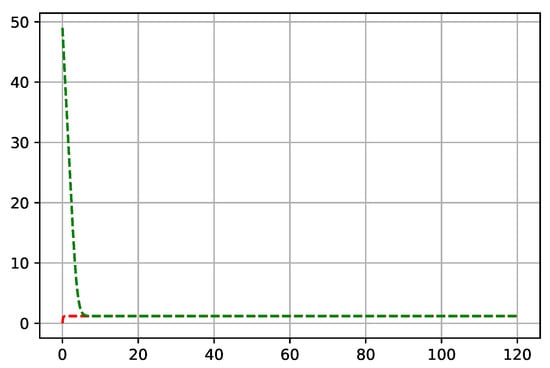
Figure 1.
Average queue size for : green corresponds to the initial condition , red—.
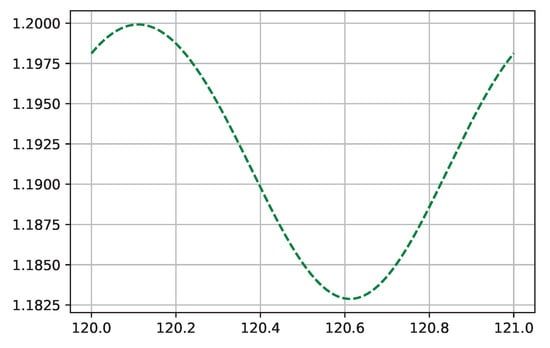
Figure 2.
Average queue size for : green corresponds to the initial conditions , .
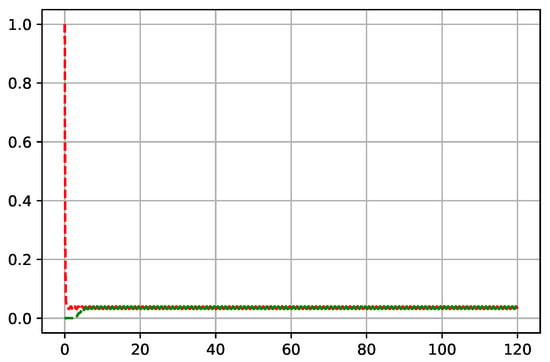
Figure 3.
Plots of for : green corresponds to the initial condition , red—.
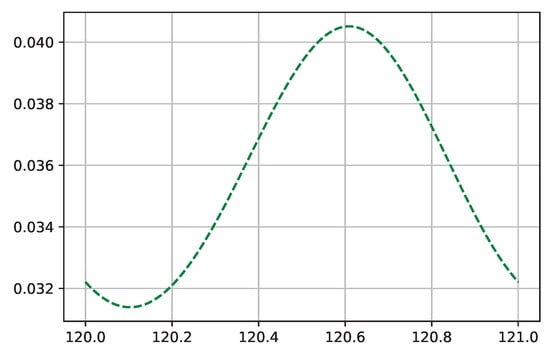
Figure 4.
Plots of for : green corresponds to the initial conditions , .
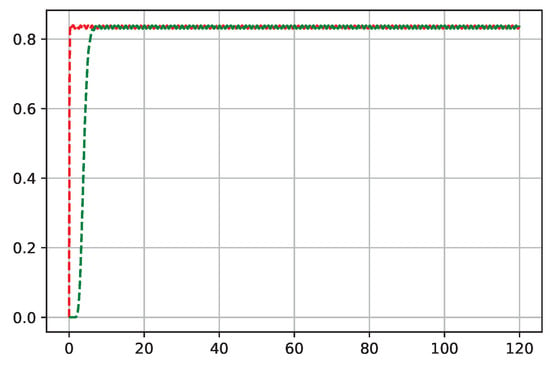
Figure 5.
Plots of for : green corresponds to the initial condition , red—.
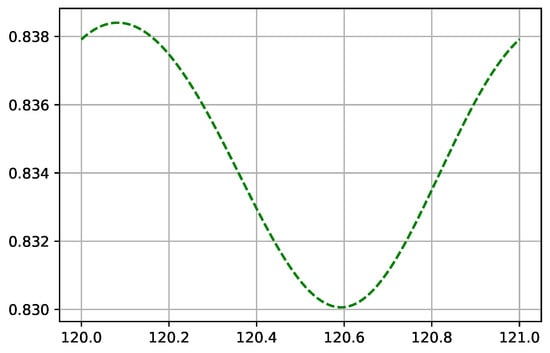
Figure 6.
Plots of for : green corresponds to the initial conditions , .
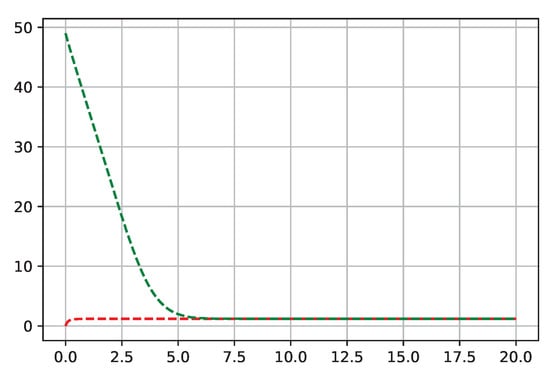
Figure 7.
Average queue-size for : green corresponds to the initial condition , red—.
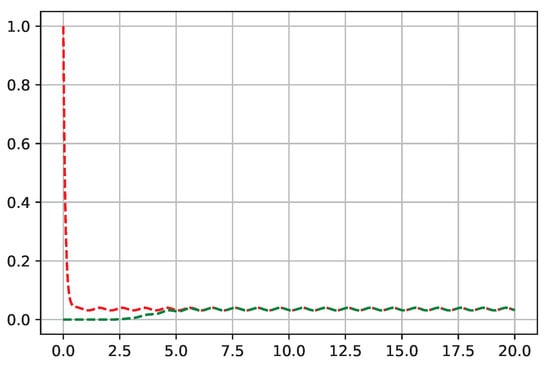
Figure 8.
Plots of for : green corresponds to the initial condition , red—.
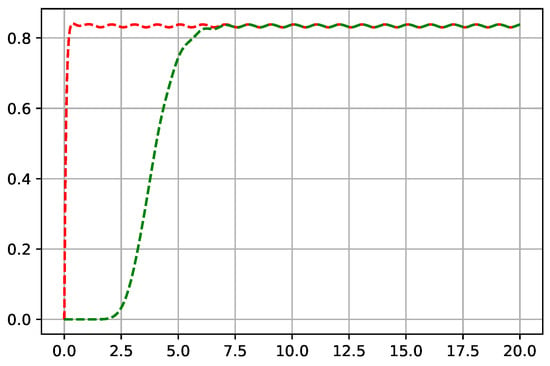
Figure 9.
Plots of for : green corresponds to the initial condition , red—.
As can be seen, the plots are drawn for three different time periods, , , and , wherefrom it can be seen how the the influence of the initial conditions vanishes.
6. Conclusions
As in the finite case, presented in [], the obtained convergence bounds for the countable case are not tight but, in general, are sufficient to build truncation bounds. They can cover quite a number of countable QBDs (and allow for various variants of partitions of infinitesimal matrices, and not only those which are chosen in this paper), and therefore the numerical solutions of systems of ODEs become feasible. One of the promising directions for further research is the relaxation of the assumptions made to obtain the upper bound (11) and establishing the convergence conditions of (10) in the case when the state space is the whole set of integers.
Author Contributions
Conceptualization, supervision, A.Z.; methodology, Y.S. and R.R.; investigation, writing, Y.S., R.R. and A.Z. All authors have read and agreed to the published version of the manuscript.
Funding
The research was supported by the Ministry of Science and Higher Education of the Russian Federation, project No. 075-15-2024-544.
Data Availability Statement
The original contributions presented in the study are included in the article. Further inquiries can be directed to the corresponding author.
Conflicts of Interest
The authors declare no conflicts of interest.
References
- Gibbens, R.; Hunt, P.; Kelly, F. Bistability in communication networks. Disord. Phys. Syst. 1990, 113–128. Available online: https://www.statslab.cam.ac.uk/~grg/books/hammfest/8-rjg.pdf (accessed on 1 January 2020).
- Boucherie, R.J.; Van Dijk, N.M. Queueing Networks: A Fundamental Approach; Springer Science & Business Media: New York, NY, USA, 2010; Volume 154. [Google Scholar]
- Gillespie, D.T. Approximate accelerated stochastic simulation of chemically reacting systems. J. Chem. Phys. 2001, 115, 1716–1733. [Google Scholar] [CrossRef]
- Novozhilov, A.S.; Karev, G.P.; Koonin, E.V. Biological applications of the theory of birth and-death processes. Briefings Bioinform. 2006, 7, 70–85. [Google Scholar] [CrossRef] [PubMed]
- Allen, L. An introduction to stochastic epidemic models. In Mathematical Epidemiology; Springer: Berlin/Heidelberg, Germany, 2008; pp. 81–130. [Google Scholar]
- Neuts, M.F. Matrix-Geometric Solutions in Stochastic Models: An Algorithmic Approach; Johns Hopkins Press: Baltimore, MD, USA, 1981. [Google Scholar]
- Bladt, M.; Neuts, M.F. Matrix-Exponential Distributions: Calculus and Interpretations via Flows. Stoch. Model. 2003, 19, 113–124. [Google Scholar] [CrossRef]
- Neuts, M.F. Structured Stochastic Matrices of M/G/1 Type and Their Applications; Marcel Dekker: New York, NY, USA, 1989. [Google Scholar]
- Liyanage, L.H.; Gulati, C.M.; Hill, J.M. A bibliography on applications of random walks in theoretical chemistry and physics. Adv. Mol. Relax. Interact. Process. 1982, 22, 5372. [Google Scholar] [CrossRef]
- Parthasarathy, P.R.; Lenin, R.B. Birth and Death Process (BDP) Models with Applications: Queueing, Communication Systems, Chemical Models, Biological Models: The State-of-the-Art with a Time-Dependent per Spective; American Series in Mathematical and Management Sciences; American Sciences Press: Columbus, OH, USA, 2004; Volume 51. [Google Scholar]
- Hautphenne, S.; Patch, B. Birth-and-Death Processes in Python: The BirDePy Package. J. Stat. Softw. 2024, 111, 1–54. [Google Scholar] [CrossRef]
- Crawford, F.W.; Ho, L.S.T.; Suchard, M.A. Computational methods for birth-death pro cesses. Wiley Interdiscip. Rev. Comput. Stat. 2018, 10, e1423. [Google Scholar] [CrossRef] [PubMed]
- Schwarz, J.A.; Selinka, G.; Stolletz, R. Performance analysis of time-dependent queueing systems: Survey and classification. Omega 2016, 63, 170–189. [Google Scholar] [CrossRef]
- Satin, Y.; Razumchik, R.; Zeifman, A.; Usov, I. On one approach to obtaining estimates of the rate of convergence to the limiting regime of Markov chains. Mathematics 2024, 12, 2763. [Google Scholar] [CrossRef]
- Daleckii, J.L.; Krein, M.G. Stability of solutions of differential equations in Banach space. Am. Math. Soc. 2002, 43, 1024–1102. [Google Scholar]
- Usov, I.A.; Satin, Y.A.; Zeifman, A.I.; Korolev, V.Y. Perturbation and truncation bounds for one class of Markov processes of birth-and-death type with catastrophes. Inform. Primen. 2025, 19, 67–73. [Google Scholar]
- Usov, I.A.; Satin, Y.A.; Zeifman, A.I. On the rate of convergence and limiting characteristics for one quasi-birth–death process. Inform. Primen. 2023, 17, 49–57. [Google Scholar]
- Usov, I.; Satin, Y.; Zeifman, A. Estimating the Rate of Convergence of the PH/M/1 Model by Reducing to Quasi-Birth-Death Processes. Mathematics 2023, 11, 1494. [Google Scholar] [CrossRef]
- Crescenzo, A.; Giorno, V.; Kumar, B.K.; Nobile, A.G. A Double-ended Queue with Catastrophes and Repairs, and a Jump-diffusion Approximation. Methodol. Comput. Appl. Probab. 2012, 14, 937–954. [Google Scholar] [CrossRef]
- Fadiloglu, M.M.; Yeralan, S. Models of production lines as quasi-birth-death processes. Math. Comput. Model. 2002, 35, 913–930. [Google Scholar] [CrossRef][Green Version]
Disclaimer/Publisher’s Note: The statements, opinions and data contained in all publications are solely those of the individual author(s) and contributor(s) and not of MDPI and/or the editor(s). MDPI and/or the editor(s) disclaim responsibility for any injury to people or property resulting from any ideas, methods, instructions or products referred to in the content. |
© 2025 by the authors. Licensee MDPI, Basel, Switzerland. This article is an open access article distributed under the terms and conditions of the Creative Commons Attribution (CC BY) license (https://creativecommons.org/licenses/by/4.0/).